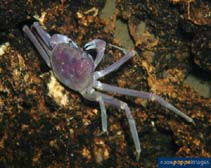Chaceon affinis (Milne-Edwards & Bouvier, 1894)
Deep-sea red crab| Native range | All suitable habitat | Point map | Year 2050 |

|
| This map was computer-generated and has not yet been reviewed. |
| Chaceon affinis AquaMaps Data sources: GBIF OBIS |
Classification / Names Common names | Synonyms | CoL | ITIS | WoRMS
Malacostraca | Decapoda | Geryonidae
Environment: milieu / climate zone / depth range / distribution range Ecology
Benthic; depth range 130 - 2047 m (Ref. 2704), usually 200 - 2000 m (Ref. 78375). Deep-water; 64°N - 33°S, 81°W - 7°E (Ref. 2747)
Distribution Countries | FAO areas | Ecosystems | Occurrences | Introductions
Southeast Pacific and north Atlantic.
Length at first maturity / Size / Weight / Age
Maturity: Lm ?, range 8 - 9.926 cm Max length : 15.5 cm CL male/unsexed; (Ref. 101417); 17.7 cm CL (female); max. published weight: 863.00 g (Ref. 2720)
Maximum length for females from Ref. 2747. This is the largest epibenthic brachyuran crab of the Family Geryonidae (Ref. 2689). Bimodal length frequency for males and unimodal for females. More males and larger individuals in shallower substratum and increasing number of females and smaller individuals in deeper substratum (Ref. 2677, 2747). This is also a target species of gillnet operators in Northeast Atlantic fisheries (Ref. 2740).
Life cycle and mating behavior Maturity | Reproduction | Spawning | Eggs | Fecundity | Larvae
Inferred from the gonadosomatic index (GDI), presence of ovigerous females and evolution of the maturity stages, occurs in autumn and winter. This supports an annual reproductive cycle. Sexual maturity with carapace lengths from 7.3 to 9.7 cm (Ref. 2747, 2751).
Main reference
References | Coordinator | Collaborators
Abellán, L.J.L., E. Balguerías and V. Fernández-Vergaz. 2002. (Ref. 2677)
IUCN Red List Status (Ref. 130435: Version 2024-1)
CITES status (Ref. 108899)
Not Evaluated
CMS (Ref. 116361)
Not Evaluated
Threat to humans
Human uses
Fisheries: commercial
| FishSource | Sea Around Us
Tools
More information
Trophic Ecology
Food items
Diet
Food consumption
Ration
Predators
Diet
Food consumption
Ration
Predators
Ecology
Population dynamics
Life cycle
Distribution
Human Related
Aquaculture profile
Stamps, Coins Misc.
Stamps, Coins Misc.
Outreach
Taxonomy
References
Internet sources
BHL | BOLD Systems | CISTI | DiscoverLife | FAO(Publication : search) | Fishipedia | GenBank (genome, nucleotide) | GloBI | Gomexsi | Google Books | Google Scholar | Google | PubMed | Tree of Life | Wikipedia (Go, Search) | Zoological Record
Estimates based on models
Preferred temperature
(Ref. 115969): 4 - 11.6, mean 8.2 (based on 168 cells).
Price category
(Ref. 80766):
Unknown.
Nutrients : Calcium = 109 [35, 184] mg/100g; Iron = 1.59 [1.21, 1.97] mg/100g; Protein = 20.2 [19.2, 21.3] %; Omega3 = 0.285 [0.185, 0.386] g/100g; Selenium = 48.3 [-31.7, 128.3] μg/100g; VitaminA = 0 μg/100g; Zinc = 1.79 [1.17, 2.40] mg/100g (wet weight); based on nutrient studies.



